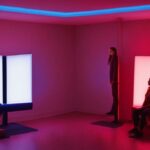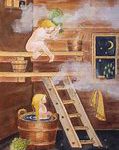Light therapy is a commonly recommended treatment for people who suffer from seasonal affective disorder (SAD) or other mood disorders. The therapy involves exposing individuals to a bright light to mimic natural sunlight, with the aim of regulating the body’s internal clock and improving mood. However, there are concerns that light therapy may interfere with sleep and cause insomnia in some individuals. This article will explore whether there is any truth to these claims and what the research says about the potential effects of light therapy on sleep.
Contents
Understanding Light Therapy
Light therapy is a non-invasive treatment that uses specific wavelengths of light to improve various health conditions. It is often used to treat seasonal affective disorder (SAD), a type of depression that occurs during the winter months when natural sunlight is scarce. Light therapy is also used to improve mood, sleep, and skin health. It is a safe and effective treatment that has been used for decades.
How Does Light Therapy Work?
Light therapy works by exposing the body to bright light, which helps to regulate the body’s circadian rhythm. The circadian rhythm is the body’s internal clock that regulates sleep and wake cycles. Exposure to bright light helps to reset the circadian rhythm, which can improve sleep and mood.
Light therapy is a non-invasive treatment that uses specific wavelengths of light to improve various health conditions. It works by exposing the body to bright light, which helps regulate the body’s circadian rhythm. While generally considered safe, light therapy can cause insomnia as a side effect, particularly in people with a history of sleep disorders, sensitivity to light, or those who use it in the evening or for an extended period of time. To prevent insomnia, light therapy should be used in the morning or early afternoon, with lower intensity, for shorter durations and under the guidance of a healthcare professional. Despite its risks, light therapy has been shown to be an effective treatment for several health conditions such as SAD, depression, jet lag, skin health, and inflammation/pain, but it should be avoided by people with certain eye conditions, skin cancer, or bipolar disorder.
While light therapy is generally considered safe and effective, there have been some reports of insomnia as a side effect. Insomnia is a sleep disorder that makes it difficult to fall asleep or stay asleep. It can be caused by a variety of factors, including stress, anxiety, and certain medications.
One study found that exposure to bright light in the evening can disrupt the body’s melatonin production, which can lead to insomnia. Melatonin is a hormone that helps regulate sleep and wake cycles. Bright light exposure can suppress melatonin production, which can make it difficult to fall asleep.
Light therapy is a safe and effective treatment that uses specific wavelengths of light to improve various health conditions. It works by exposing the body to bright light, which helps to regulate the body’s circadian rhythm, the internal clock that regulates sleep and wake cycles. While light therapy is generally safe, there have been reports of insomnia as a side effect, especially for people with a history of sleep disorders, light sensitivity, or those who use light therapy in the evening or at night. To prevent insomnia, it’s important to use light therapy in the morning or early afternoon, use a lower intensity light source, reduce the duration of light therapy sessions, and use light therapy under the guidance of a healthcare professional. It’s also important to use light therapy safely by wearing eye protection and following the guidelines provided by a healthcare professional.
Who Is at Risk of Insomnia from Light Therapy?
Not everyone who undergoes light therapy will experience insomnia. However, certain groups of people may be at higher risk. These include:
- People with a history of sleep disorders
- People who are sensitive to light
- People who undergo light therapy in the evening or at night
- People who use light therapy for an extended period of time
If you fall into one of these groups or have concerns about insomnia, it’s important to talk to your doctor before starting light therapy.
Light therapy is a safe and effective treatment that uses specific wavelengths of light to improve various health conditions, especially seasonal affective disorder (SAD). While light therapy works by exposing the body to bright light, which helps to regulate the body’s circadian rhythm, there have been some reports of insomnia as a side effect. However, not everyone who undergoes light therapy will experience insomnia, and certain groups of people may be at higher risk. To prevent insomnia, it’s important to use light therapy in the morning or early afternoon, use a lower intensity light source, reduce the duration of light therapy sessions, and use light therapy under the guidance of a healthcare professional. While light therapy is generally considered safe, there are some people who should avoid it and some risks associated with the treatment, such as headache, eyestrain, nausea, irritability, and insomnia. To use light therapy safely, it’s important to follow some guidelines, such as using a light box or lamp that emits white light, starting with a low intensity, and using light therapy at the same time every day.
How to Prevent Insomnia from Light Therapy
If you’re undergoing light therapy and are worried about insomnia, there are several steps you can take to prevent it. These include:
- Using light therapy in the morning or early afternoon, rather than in the evening or at night
- Using a lower intensity light source
- Reducing the duration of light therapy sessions
- Using light therapy under the guidance of a healthcare professional
If you experience insomnia after starting light therapy, it’s important to talk to your doctor. They may be able to adjust your treatment or recommend other strategies to help you sleep better.
Light therapy is a safe and effective treatment that uses specific wavelengths of light to improve various health conditions, including seasonal affective disorder (SAD), sleep and skin health. However, exposure to bright light in the evening or at night can disrupt the body’s melatonin production, leading to insomnia, especially for certain groups of people, like those with a history of sleep disorders or sensitivity to light. To prevent insomnia, it’s important to use light therapy in the morning or early afternoon, under the guidance of a healthcare professional, for a shorter duration and with lower intensity. Insomnia is among the common side effects of light therapy, which also includes headache, eyestrain, nausea, and irritability. People with certain eye and skin conditions, who are at high risk for skin cancer, taking medication that increases sensitivity to light and those with bipolar disorder should avoid using light therapy.
The Benefits of Light Therapy
Light therapy has been shown to be an effective treatment for a variety of health conditions. Some of the most common benefits of light therapy include:
- Treating seasonal affective disorder (SAD)
- Improving mood and reducing symptoms of depression
- Regulating sleep and wake cycles
- Treating jet lag
- Improving skin health
- Reducing inflammation and pain
- Treating certain skin conditions, such as psoriasis and eczema
Light therapy is a safe and effective treatment that uses specific wavelengths of light to improve various health conditions, including seasonal affective disorder (SAD), sleep, and skin health. However, exposure to bright light in the evening can disrupt the body’s melatonin production, which can lead to insomnia. People with a history of sleep disorders, sensitivity to light, or who use light therapy for an extended period of time may be at higher risk of insomnia from light therapy. To prevent insomnia, it’s important to use light therapy in the morning or early afternoon, use a lower intensity light source, reduce the duration of light therapy sessions, and use it under the guidance of a healthcare professional. While light therapy is generally considered safe, there are some people who should avoid it, such as those with certain eye conditions, a history of skin cancer, or who are taking certain medications. To use light therapy safely, it’s important to follow certain guidelines, such as starting with a low intensity and gradually increasing it over time, using it at the same time every day, and wearing eye protection if recommended by your doctor.


.jpg)
.jpg)



